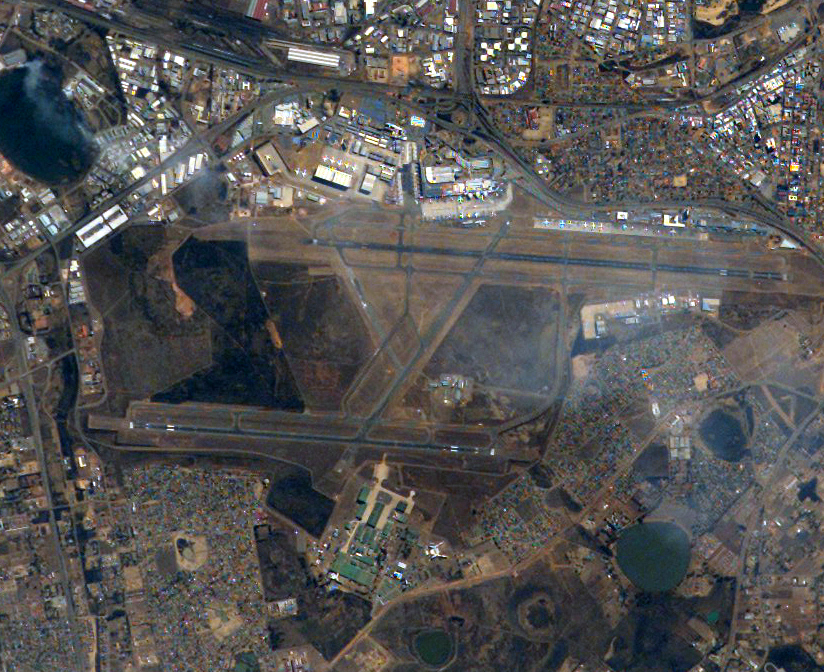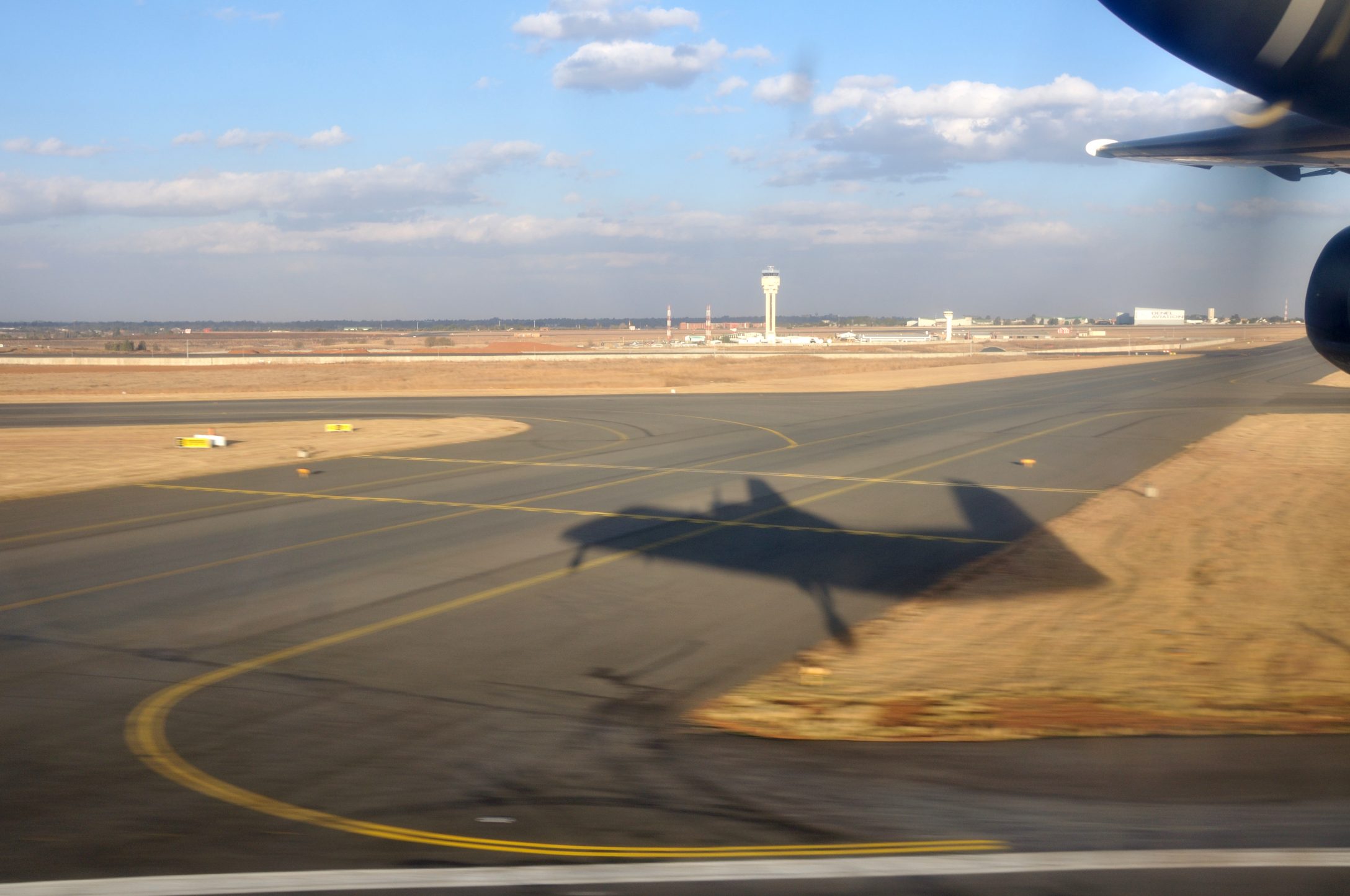The world’s major airports aren’t in cities. Their giant aprons, terminals and endless runways stretch over the edges of small towns and suburbs. So, when you take plane from Cape Town to London, you’re actually flying from Matroosfontein to Longford. Emirates’ A380 service between Milan and New York City, is really Emirates’ A380 service between Ferno and Queens.
I think about this every time I fly, because I was one of those kids that grew up in a suburb near a major airport: O.R. Tambo International.
It’s officially in the town of Kempton Park and sits high up on the gold-bearing Highveld of South Africa’s interior, at approximately 5,500 feet above sea-level. Here the air is so thin that aircraft manufacturers send their new planes to test them in hot-and-high conditions. Even the Concorde, the supersonic jet that could get you from Longford to Queens in just over three hours, swooped over our house during its test phase in the late 60s and early 70s. But that was before I was born.
When I was growing up, before the release of Nelson Mandela and the fall of the Apartheid government, the airport was called Jan Smuts International Airport, named after the South African strongman of post-war politics, a segregationist. The first post-democracy government changed its name to Johannesburg International, referring to the city almost 30 kilometres away. Eventually, the airport was renamed again—this time after Oliver Tambo, a member of the African National Congress who took power in 1994, just as I was leaving high school.
These days, I live in Belgium. Whenever I travel by plane, it takes off from the country’s major airport in Zaventem, a small commune on the edge between Flanders and Brussels. I always look down at the tiny gridwork of suburban roads and steeples and boulangers that surround the airport. I remember the suburb where I used to lie on the lawn and watch the jets fly over our house, coming or going through Africa’s biggest gateway.
As a family, we hardly flew. But the passenger jets were a part of our everyday existence. The noise of the turbofans, spooling up and down as they approached the runway, a few kilometres away, punctuated our dinners. Invariably, on Sunday evenings, a thundering quad-jet would rattle our windows as it took off toward Longford, Ferno, Zaventem, Kloten or any of the other countless suburbs of Europe.

Growing up in Kempton Park meant that many of my school friends’ parents were employed by either the airport or the national airline. One of my friends gave me a copy of a booklet that contained the flight schedules of the airport. I memorised it. This meant I could sit in our garden and check where the planes that were passing over came from, or where they were going. I also became adept at distinguishing the different types of engine noises so, even if I was inside, I could tell if the plane flying over our rooftop was a Boeing 737, Airbus A300, or the Queen of the Skies: a 747.
When I was growing up, the airport was generally a harbinger of good. Every few months, my mother, sister and I would drive the ten or so minutes to where my grandmother would be delivered into the arrivals hall. She lived far away and was basically blind. She needed to come to Johannesburg often for surgery on her cataracts and corneas. Her visits smelled of Rothmans Select cigarettes (though she insisted she never inhaled) and peppermint lozenges; we had long conversations about love, death, and her invisible God.
The airport also kept the demons of the dark at bay. I have a distinct memory of laying awake in my bed, seven or eight years old, while the rest of the house was sleeping, and fearing the dark and the quiet. Everyone in the world was sleeping and it would have been a perfect time for monsters to strike. But then a cargo plane would sail over our dark street and I’d relax. I knew one of my friends’ dads would be up in the control tower, aircraft to the runway and that there would be staff to direct it to its stand.
Then one night in 1987, when I was 13, a South African Airways 747, named the Helderberg, took off from Taoyuan City in Taiwan, headed to our suburb. Its arrival time would have been printed in my well-thumbed book. But it never appeared over our house. Somewhere over the Indian Ocean, a fire started in its cargo bay and destroyed the jet’s critical systems one by one. Controllers at the airport in Mauritius, sitting high up in their tower in Plaisance, listened helplessly to the frantic midnight radio calls from its crew, as the plane plunged into the waves. 159 people died.
The accident brought a lot of tension to our community. A good friend of mine’s dad was the head engineer on the 747 maintenance crew and personally signed the Helderberg out before it left Kempton Park for the last time for Taiwan. In the mornings at school, my friend would whisper to me. Their home telephone was ringing at all hours of the night, from high profile people in the airline and government, demanding more details from his father.
Conspiracy theories swirled. Some said the apartheid government had used the passenger jet to ferry secret weapon systems back to South Africa from the East, as sanctions prevented them from buying their weapons on the open market. This opened up another worst-case possibly: that potentially the crippled plane could have made it to Mauritius, but that the international embarrassment of a plane landing on foreign soil, passengers already dead from inhaling noxious gasses, would have been too great. The commander, an ex-Air Force pilot, perhaps in a final moment of loyalty to his country, ditched the plane into the sea.
The mysteries surrounding the crash were never entirely solved, despite years of hearings and commissions. I heard the tapes from the plane, though.
Another friend’s dad was part of the mission to retrieve critical parts from the ocean. One day, a few of us were at her house and he played us a recording from the cockpit voice recorder. What I heard sounded like a raw and panicked will to survive.
This friend’s dad also showed us a polystyrene cup that he had retrieved in a Gemini submarine, along with other wreckage from the ocean floor. The cup was still perfectly shaped, but compressed to about half its size due to the pressure at that depth.
There were other minor incidents that rattled us. One Sunday morning, driving home from church, we found ourselves stuck in unusually heavy traffic. It turned out that a 20-seater twin-prop didn’t quite make it to runway 3L and crash-landed over an intersection a few blocks from our house, missing every car on the road and plowing through the asbestos wall around someone’s house. The landing gear of the plane was in their pool. Incredibly, all passengers and crew emerged from that plane unscathed. But the crash landing really put a damper on that family’s Sunday plans.
More often than not, so often that it hardly bears noting, the planes came and went without a hitch. The regularly timed takeoffs and landings were a comfort in my childhood. The airport with its many names made me dream of other places beyond Kempton Park. Eventually I left.
But perhaps most powerfully, the airport made me aware of things beyond our planet, beyond life. The image of the compressed polysterene cup is still perfectly preserved in my memory. For some reason, I often retrieve it into my conscious mind and meditate on it.






